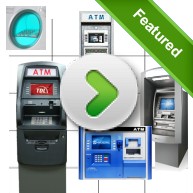
ATM machines
An ATM consists of different parts that all work together to conduct a transaction.
1. The CPU. The central processing unit is the brains behind the machine. Like a small computer the CPU controls the electronics in the machine.
2. The Display. The Display is a monitor that shows information choices on the screen.
3. The CDU. Cash Dispenser Unit. The cash dispenser does what it says, it dispenses bills. Most are 800 or 1000 note dispensers and can go up to 2000 notes.
4. Card Reader. All card readers are either swipe or DIP. Swipe is where the card is swiped through a reader. A DIP requires the card to be inserted into a slot to be read.
5. Modem. ATMs are designed to operate on standard analog phone lines. They do not do well on digital phone lines. The ATM must dial out to get approval before dipensing cash.
6. Vault Lock. The vault lock protects the vault and money inside. Standard locks are spin combination. Electronic locks require you to key in a combination.
7. Receipt printer. The receipt printer is usually thermal requiring no ink. Paper rolls supply the printer. Not all machines use the same paper.
8. Sensors. There are sensors all through an ATM. Sensors detect if the bills are being dispensed properly. They also detect if the vault door or service door has been opened.